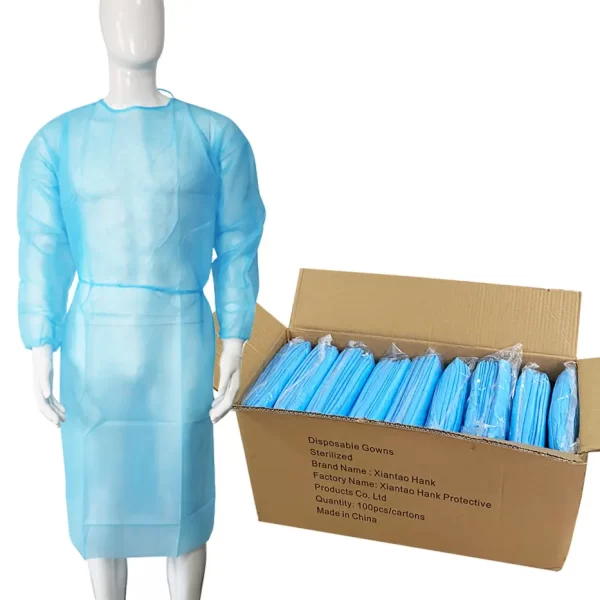Nonwoven Isolation Gowns: What You Need to Know Before Making a Purchase
Introduction:
In the rapidly evolving landscape of healthcare and medical supplies, nonwoven isolation gowns have emerged as a critical component. These gowns, designed to provide a high level of protection against infectious diseases, have become a staple in hospitals, clinics, and other healthcare settings. However, before you make a purchase, there are several factors you need to consider. This comprehensive guide will walk you through the essential aspects of nonwoven isolation gowns, ensuring you make an informed decision that meets your specific needs.
Understanding Nonwoven Isolation Gowns:
Nonwoven isolation gowns are made from nonwoven materials, which are fabrics that are bonded together without weaving or knitting. The process involves entangling fiber or filaments mechanically, thermally, or chemically. They are flat, porous sheets that are made directly from separate fibers or from molten plastic or plastic film. This unique construction gives nonwoven fabrics specific functions such as absorbency, resilience, stretch, softness, strength, flame retardancy, washability, cushioning, filtering, bacterial barriers, and sterility.
These gowns are designed to be disposable, providing a cost-effective solution for infection control. They are typically used in situations where there is a risk of exposure to infectious materials, providing a barrier between the wearer and potential contaminants.
Key Factors to Consider:
Material Quality:
The quality of the material used in the gown is paramount. Nonwoven materials can vary significantly in terms of their resistance to fluids and microorganisms. Look for gowns that are made from high-quality, durable nonwoven materials that can withstand the rigors of a healthcare setting.
Nonwoven fabrics for isolation gowns are usually made from polypropylene, polyester, polyethylene, or something similar. To ensure you are getting a high-quality product, look for gowns that have been tested to meet high industry standards. The material should be resistant to tearing and puncturing, and it should also be soft and comfortable for the wearer.
Level of Protection:
Nonwoven isolation gowns come in different levels of protection, typically categorized by the Association for the Advancement of Medical Instrumentation (AAMI) standards. These levels range from 1 (minimal risk) to 4 (high risk). The level you choose should align with the potential risk of exposure in your specific setting.
Level 1 gowns are used in minimal risk situations such as basic care, standard hospital medical units, and visitor areas. Level 2 gowns are used in low risk situations where there is only a slight risk of liquid splash. Level 3 gowns are used in moderate risk situations like drawing arterial blood, inserting an IV, and emergency rooms. Level 4 gowns are used in high risk situations like surgery and when there is a risk of fluid penetration.
Comfort and Fit:
Comfort should not be compromised for protection. Nonwoven isolation gowns should be comfortable to wear for extended periods and should fit well to ensure maximum protection. Look for gowns with features like elastic cuffs, back ties, and ample coverage.
The design of the gown is also important. It should be easy to put on and take off without contaminating the wearer. The gown should have long sleeves to protect the arms, and it should cover the body from the neck to the knees. The back of the gown should have a tie or a belt so that it can be adjusted for a comfortable fit.
Certifications:
Ensure that the gowns you purchase meet the necessary industry standards and certifications. This includes FDA approval and compliance with AAMI standards. Certifications are a testament to the gown’s quality and efficacy.
The FDA regulatesmedical devices in the U.S., and isolation gowns are classified as Class I or Class II devices, depending on the level of risk, and whether they’re intended for surgeons or for patients. Class I devices are considered low risk, and are subject to General Controls, while Class II devices are higher risk, and are subject to Special Controls, which may include standards development, postmarket surveillance, patient registries and FDA guidelines.
Cost:
While cost should not be the sole deciding factor, it is an important consideration. Nonwoven isolation gowns are typically more cost-effective than their woven counterparts, but prices can vary based on the factors mentioned above.
When considering the cost, it’s important to look at the total cost of ownership, which includes the cost of the gown, the cost of disposal, and the cost of potential infections that could occur if the gown does not provide adequate protection. It’s also important to consider the cost of comfort. If a gown is uncomfortable, healthcare workers may be less likely to wear it, which could increase the risk of infection.
Environmental Impact:
In addition to the factors mentioned above, it’s also important to consider the environmental impact of nonwoven isolation gowns. Because they are designed to be disposable, they can generate a significant amount of waste. Some manufacturers are addressing this issue by developing gowns made from biodegradable materials. Others are exploring the use of reusable gowns that can be washed and sterilized.
Conclusion:
Nonwoven isolation gowns are an essential part of infection control in healthcare settings. By considering the factors outlined in this article, you can ensure that you make a purchase that offers the right balance of protection, comfort, and cost-effectiveness. Remember, the goal is not just to buy a gown, but to invest in the safety and well-being of your healthcare team.
In the end, the choice of isolation gowns is a critical decision that can have a significant impact on the safety and well-being of healthcare workers and patients. By taking the time to understand the different factors that should be considered, you can make an informed decision that will provide the best possible protection.
Please visit our website for more product details https://medposnonwoven.com/product/pp-nonwoven-isolation-gowns/

